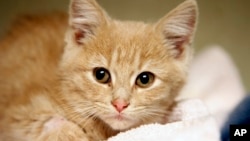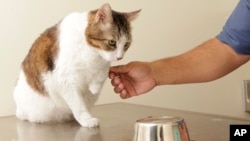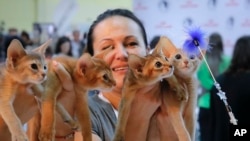A new study has found that cats can connect with people in the same way as dogs and children.
The research, published in Current Biology, suggests the social abilities of cats to form human attachments has been greatly underestimated.
The study notes that more cats live with humans than dogs do worldwide. But historically, more scientific research has centered on the social relationships between people and dogs.
In experiments with cats and humans, the researchers found that cats do show specific “attachment styles toward human caregivers.” This suggests that cats share some of the same social abilities that historically have only been linked to dogs.
Kristyn Vitale is a researcher at the Human-Animal Interaction Lab at Oregon State University. She was the lead writer of the study.
In a statement, she said the evidence suggests that both cat and dog attachments to humans may represent the same kind of connection that exists between children and their caretakers.
“Our study indicates that when cats live in a state of dependency with a human, that attachment behavior is flexible and the majority of cats use humans as a source of comfort.”
The researchers designed experiments similar to methods used to measure human attachment behaviors. For example, other studies have observed how babies react to being reunited with caregivers after being separated for short periods.
In this experiment, adult and young cats first spent two minutes in a room with their caregiver. The cats then spent two minutes in the room alone, followed by a two-minute reunification period with the caregiver.
About 70 cats were studied. The behavior of the animals was observed by experts who divided them into two groups. Sixty-four percent were judged to be “securely attached” to caregivers, while 36 percent were found to be “insecurely attached.”
The cats with secure attachments showed several signs of “reduced stress” levels, the study found. These cats were found to be more comfortable and effectively balanced their attention between the person and their surroundings.
However, the cats with an insecure attachment showed clear signs of stress. These included shaking of the tail, repeated licking or staying completely away from the caregiver.
Of the insecure cats studied, 84 percent were judged to be “ambivalent.” Twelve percent were found to be “avoidant,” while four percent were considered “disorganized.”
Kristyn Vitale said there is a long-held societal belief that all cats like “to run and hide or seem to act aloof.” But she said the experiments showed that cats are more likely to behave this way when they are insecure. “The majority of cats use their owner as a source of security. Your cat is depending on you to feel secure when they are stressed out,” Vitale said.
She added that the results showed that the level of secure and insecure attachments in cats is very close to those measured in human babies. In humans, research has found that 65 percent of babies are also securely attached to their caregivers.
The researchers also were interested in finding out if socialization training would change the results. But after a six-week training program for the cats, there were no major differences.
“Once an attachment style has been established between the cat and its caregiver, it appears to remain relatively stable over time, even after a training and socialization intervention,” Vitale said.
I’m Bryan Lynn.
Bryan Lynn wrote this story for VOA Learning English, based on reports from Current Biology and Oregon State University. Mario Ritter Jr. was the editor.
We want to hear from you. Write to us in the Comments section, and visit our Facebook page.
________________________________________________________________
Words in This Story
style – n. a way of doing something
indicate –v. to show or suggest something
flexible – adj. able to change or be easily changed
comfort – n. a feeling of being relaxed and comfortable
stress – n. feelings or worry or nervousness caused by difficult situations or problems
lick – v. the moving of the tongue by a person or animal
ambivalent – adj. having mixed feelings about something or someone
aloof – adj. not friendly; disinterested in being involved in something
stable – adj. not likely to change or end















